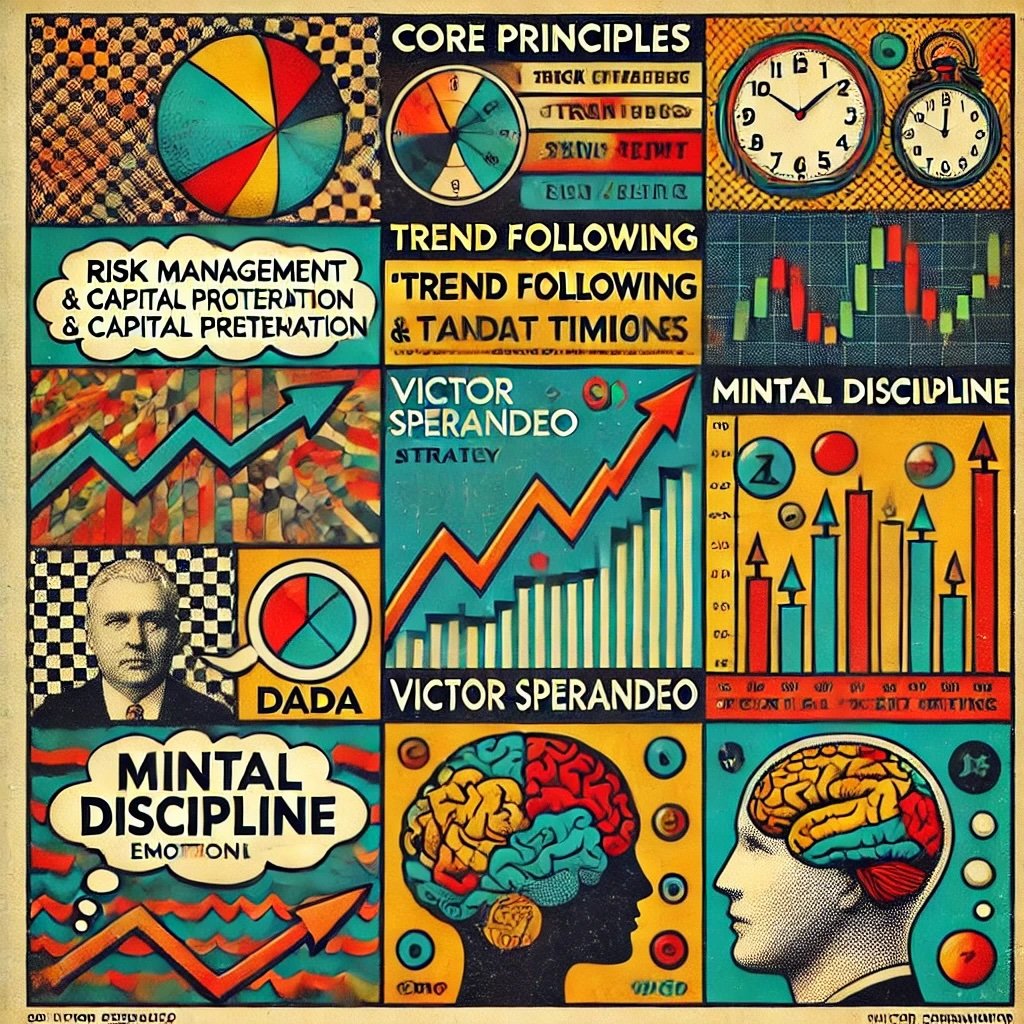Investing like Victor Sperandeo, affectionately known as “Trader Vic,” means mastering the art of technical analysis, implementing strategic risk management, and cultivating a disciplined mindset. As a renowned market strategist and a star of the Market Wizards series, Sperandeo has significantly influenced countless traders with his insightful strategies and profound market understanding. Whether you’re a novice investor or a seasoned trader, adopting Sperandeo’s principles can elevate your trading game, leading to consistent success and impressive returns. In this comprehensive guide, we’ll delve into Victor Sperandeo’s trading philosophy, explore his core strategies, and provide actionable insights to help you emulate his success in the trading world.
source: Trend Following on YouTube
Victor Sperandeo: The Legendary “Trader Vic”
Victor Sperandeo, widely recognized as “Trader Vic,” is a luminary in the trading community. His remarkable journey from a floor trader to a celebrated market strategist and author has inspired traders worldwide. Known for his sharp market insights and disciplined trading approach, Sperandeo has consistently demonstrated the ability to navigate complex market conditions with ease and precision.
![]()
Understanding Bond Trading and Its Significance
Bond trading involves buying and selling debt securities, such as government and corporate bonds, to capitalize on interest rate fluctuations and credit quality changes. As a cornerstone of the global financial system, the bond market plays a crucial role in financing governments, corporations, and other entities. Its significance lies in providing investors with opportunities to generate income, preserve capital, and diversify their investment portfolios.
We’ll explore Victor Sperandeo’s trading strategies and his profound influence on bond trading and market analysis. By understanding his approach, investors can gain valuable insights into building and implementing effective trading systems. From risk management to psychological discipline, we’ll cover the multifaceted aspects that make Victor Sperandeo a legendary figure in trading.

Who is Victor Sperandeo?
Background and Early Life of Victor Sperandeo
Victor Sperandeo was born in the vibrant city of New York City. From an early age, he exhibited a keen interest in understanding financial markets and the intricacies of trading. His academic pursuits led him to earn a degree in finance, laying a solid foundation for his future career. Sperandeo’s early exposure to the bustling financial district of Manhattan ignited his passion for trading, setting him on a path to financial mastery.
Journey from Floor Trader to Renowned Market Strategist and Author
Sperandeo’s professional journey began on the trading floors of Wall Street, where he worked as a floor trader. The high-energy environment and the relentless pace of the trading floors provided him with invaluable hands-on experience. His exceptional ability to analyze market trends and execute strategic trades quickly set him apart from his peers.
In the early stages of his career, Sperandeo focused primarily on U.S. Treasury bonds, leveraging their liquidity and stability to build a strong foundation in bond trading. His success on the trading floors caught the attention of major financial institutions, leading to opportunities that allowed him to scale his strategies and influence within the industry.
Key Achievements: Books and Market Wizards Series
- Author of Influential Books: Sperandeo has authored several best-selling books that delve into the psychology of trading and system development. His works, such as Trader Vic: Methods of a Wall Street Master and Trader Vic II: Principles of Professional Speculation, provide comprehensive guides on building personalized trading systems and overcoming psychological barriers in trading.
- Star of Market Wizards: Featured in Jack Schwager’s acclaimed series Market Wizards, Sperandeo shares his trading philosophies and experiences, offering invaluable lessons to traders seeking to emulate his success.
- Founder of Action Planning Systems: Beyond writing, Sperandeo founded Action Planning Systems, a company dedicated to educating traders and investors on effective trading strategies and risk management techniques.
- Mentorship and Influence: Through seminars, workshops, and personal coaching, Sperandeo has mentored countless traders, instilling in them the principles of disciplined trading and strategic market analysis.

The Trader Vic Approach to Markets
Overview of Sperandeo’s Trading Style
Victor Sperandeo’s trading style is a harmonious blend of technical analysis and fundamental insights. He places a strong emphasis on understanding market cycles and trend dynamics, using them as the backbone of his trading decisions. Sperandeo’s approach is methodical, relying on data-driven analysis rather than intuition, which allows him to navigate volatile markets with confidence and precision.
Combining Technical Analysis with Economic and Market Fundamentals
While technical analysis forms the core of Sperandeo’s strategy, he seamlessly integrates economic and market fundamentals to enhance his trading decisions. This dual approach enables him to gain a comprehensive view of the markets, identifying not only technical patterns but also underlying economic drivers that influence price movements.
Key Elements of His Combined Approach:
- Technical Indicators: Utilizing tools such as Moving Averages, Relative Strength Index (RSI), and Bollinger Bands to identify entry and exit points.
- Economic Data: Incorporating macroeconomic indicators like GDP growth, inflation rates, and employment figures to assess the health of economies and their impact on bond prices.
- Market Sentiment: Gauging the overall sentiment in the market to anticipate potential reversals or continuations in trends.
Importance of Understanding Market Cycles and Trends
A deep understanding of market cycles and trend identification is crucial to Sperandeo’s trading strategy. Market cycles represent the recurring phases of expansion and contraction that characterize economic activity, while trends indicate the general direction of market prices over time. By identifying these patterns, Sperandeo can position his trades to capitalize on the prevailing market conditions.
Benefits of Understanding Market Cycles:
- Predicting Market Movements: Recognizing where the market is within a cycle helps in forecasting future price movements, enabling strategic entry and exit points.
- Strategic Positioning: Aligning trading positions with the phase of the market cycle enhances the probability of success, whether the market is trending upwards or downwards.
- Risk Mitigation: Understanding the cyclical nature of markets allows for better risk management, as traders can anticipate potential downturns and adjust their strategies accordingly.
Case Study: Adapting to Market Trends
One of the notable instances where Sperandeo’s approach was evident is his handling of the bond market during periods of high volatility. By combining technical indicators with macroeconomic analysis, he was able to predict shifts in bond prices and adjust his positions to maximize returns while minimizing risks.

Core Principles of Victor Sperandeo’s Trading Strategy
1. Risk Management: Emphasis on Capital Preservation and Risk Control
Risk management is the cornerstone of Sperandeo’s trading philosophy. He believes that preserving capital is paramount, as it provides the necessary cushion to withstand inevitable market downturns and unexpected losses. His approach to risk management is meticulous and multifaceted, ensuring that traders can protect their investments while still capitalizing on profitable opportunities.
Key Aspects of Risk Management:
- Position Sizing: Determining the appropriate amount to invest in each trade based on the level of risk and the trader’s overall portfolio.
- Stop-Loss Orders: Implementing stop-loss orders to limit potential losses on any given trade, ensuring that no single position can significantly impact the overall portfolio.
- Diversification: Spreading investments across various asset classes, sectors, and geographies to mitigate risk and reduce exposure to any single market event.
2. Trend Following: Strategies for Identifying and Following Market Trends
Trend following is a fundamental aspect of Sperandeo’s trading strategy. By identifying and aligning with prevailing market trends, he maximizes the potential for profitable trades while minimizing exposure to counter-trend movements.
Key Strategies for Trend Following:
- Moving Averages: Utilizing moving averages to identify the direction and strength of a trend. For example, a rising moving average indicates an uptrend, while a declining one signals a downtrend.
- Momentum Indicators: Using indicators like RSI and MACD to gauge the momentum behind a trend, helping to confirm its sustainability.
- Price Action: Analyzing price patterns and chart formations to identify trend continuations or reversals, enabling timely entry and exit points.
3. Market Timing: The Significance of Timing in Entering and Exiting Trades
Market timing is crucial for optimizing trading performance. Sperandeo emphasizes the importance of entering and exiting trades at the right moments to maximize gains and minimize losses.
Key Elements of Market Timing:
- Entry Signals: Identifying specific technical or fundamental signals that indicate an optimal time to enter a trade, such as breakouts, reversals, or confirmations from multiple indicators.
- Exit Strategies: Establishing clear criteria for exiting trades, whether it’s hitting a target profit, triggering a stop-loss, or identifying signs of trend exhaustion.
- Patience and Discipline: Exercising patience to wait for the right opportunities and discipline to stick to the predetermined entry and exit points, avoiding impulsive decisions based on emotions or market noise.
4. Mental Discipline: The Psychological Aspects of Trading and Maintaining Emotional Control
Mental discipline is a critical component of Sperandeo’s trading strategy. He believes that mastering one’s emotions and maintaining psychological resilience are essential for consistent trading success.
Key Aspects of Mental Discipline:
- Emotional Regulation: Implementing techniques to manage emotions such as fear, greed, and overconfidence, ensuring that trading decisions are based on logic and analysis rather than emotions.
- Consistent Execution: Adhering strictly to the trading plan and strategies, avoiding deviations based on short-term market fluctuations or emotional impulses.
- Self-Awareness: Cultivating self-awareness to recognize personal biases and emotional triggers, enabling proactive management of psychological challenges in trading.
Integration of Core Principles
Victor Sperandeo’s trading strategy seamlessly integrates these core principles. By combining disciplined risk management, effective trend following, precise market timing, and strong mental discipline, he creates a comprehensive and effective trading framework capable of navigating the complexities of financial markets.

Famous Trades and Market Calls
1. The Gold Rally Trade (2010-2011)
One of Sperandeo’s most notable trades was his long position on gold during the 2010-2011 gold rally. Anticipating increased demand for gold as a hedge against inflation and economic uncertainty, Sperandeo capitalized on the rising prices by allocating significant capital to gold futures.
Strategy Behind the Trade:
- Economic Indicators: Observed rising inflation rates and economic uncertainties that typically boost gold prices.
- Technical Analysis: Identified bullish trends through moving averages and breakout patterns in gold charts.
- Market Sentiment: Recognized the growing investor sentiment favoring safe-haven assets amidst geopolitical tensions and market volatility.
Outcome and Impact:
The trade yielded substantial profits as gold prices surged, reinforcing the effectiveness of combining technical analysis with fundamental economic insights. This success highlighted Sperandeo’s ability to anticipate market movements and execute timely, profitable trades.
2. Shorting the Japanese Yen (2013)
In 2013, Sperandeo identified an opportunity to short the Japanese Yen based on expectations of a weakening economy and aggressive monetary easing by the Bank of Japan.
Strategy Behind the Trade:
- Economic Fundamentals: Anticipated continued monetary easing policies, leading to a depreciation of the Yen.
- Technical Indicators: Noted bearish patterns and declining momentum in Yen charts.
- Market Sentiment: Capitalized on negative sentiment towards the Yen amid economic stagnation concerns.
Outcome and Impact:
The Yen depreciated significantly against the U.S. dollar, resulting in a profitable short position for Sperandeo. This trade underscored the importance of aligning technical signals with fundamental economic analysis to execute successful trades.
3. Navigating the 2008 Financial Crisis
During the 2008 financial crisis, Sperandeo adeptly navigated the turbulent markets by maintaining a balanced portfolio and implementing rigorous risk management techniques.
Strategy Behind the Trade:
- Diversification: Held a diversified portfolio across various asset classes to mitigate sector-specific risks.
- Capital Preservation: Prioritized capital preservation by reducing exposure to highly volatile and risky assets.
- Strategic Hedging: Utilized hedging strategies, such as short positions in equities, to protect against significant market downturns.
Outcome and Impact:
While many traders suffered substantial losses during the crisis, Sperandeo’s disciplined approach and robust risk management allowed him to preserve capital and even capitalize on certain distressed assets. This experience reinforced the critical role of risk management and diversification in safeguarding investments during economic downturns.
Key Takeaways from Sperandeo’s Famous Trades
- Comprehensive Analysis: Successful trades are built on a foundation of thorough economic, geopolitical, and technical analysis.
- Timing is Crucial: Entering and exiting trades at the right time can significantly amplify profits and reduce risks.
- Adaptability: Being flexible and willing to shift strategies in response to changing market conditions is essential for sustained success.
- Risk Management: Implementing disciplined risk management techniques ensures that capital is preserved, even when trades do not go as planned.
Relevance of Sperandeo’s Trades Today
The principles demonstrated in Sperandeo’s famous trades remain highly relevant in today’s financial markets. With the advent of new technologies, evolving economic landscapes, and unprecedented global events, the need for a disciplined, analytical, and adaptable trading approach has never been greater. Traders can draw inspiration from these trades to develop strategies that are both robust and flexible, capable of navigating the complexities of modern markets.

Risk Management Techniques
Detailed Look at Sperandeo’s Approach to Managing Risk
Risk management is not just a component of Sperandeo’s trading strategy; it’s the foundation upon which his entire trading philosophy is built. By prioritizing capital preservation and implementing disciplined risk management protocols, Sperandeo ensures that his trading activities are sustainable and resilient, even in volatile markets.
1. Use of Stop-Loss Orders
Stop-loss orders are essential tools for limiting potential losses on trades. Sperandeo employs stop-loss orders to protect his capital and maintain a controlled risk environment.
Implementing Stop-Loss Orders:
- Strategic Placement: Placing stop-loss orders at key technical levels, such as support or resistance zones, to avoid being prematurely stopped out by minor price fluctuations.
- Dynamic Stops: Adjusting stop-loss levels based on evolving market conditions and the strength of the trade, allowing for flexibility while maintaining protection.
- Automated Execution: Utilizing automated trading systems to ensure that stop-loss orders are executed promptly, removing emotional bias from the decision-making process.
2. Position Sizing: Allocating Risk Appropriately
Position sizing involves determining the appropriate amount to invest in each trade based on the level of risk and the trader’s overall portfolio.
Key Strategies for Position Sizing:
- Fixed Fractional Method: Allocating a fixed percentage of the portfolio to each trade, ensuring that no single position can disproportionately impact the overall portfolio.
- Volatility-Based Sizing: Adjusting the size of each position based on the volatility of the asset being traded. More volatile assets receive smaller positions to mitigate risk.
- Risk-Reward Assessment: Evaluating the potential risk and reward of each trade to determine the optimal position size, aiming for trades where the potential reward justifies the risk.
3. Diversification: Spreading Risk Across Markets
Diversification involves spreading investments across various asset classes and regions to reduce exposure to any single source of risk.
Diversification Strategies:
- Asset Class Selection: Investing in a mix of equities, bonds, commodities, and currencies to balance risk and return. Each asset class responds differently to market conditions, providing a hedge against adverse movements in any single market.
- Geographical Diversification: Allocating investments across different regions to mitigate the impact of localized economic downturns. This ensures that geopolitical events or regional economic issues do not disproportionately affect your portfolio.
- Sector Diversification: Spreading investments across various sectors to avoid concentration risk and capitalize on opportunities in different industries. Sector diversification provides additional layers of protection and growth potential.
4. Hedging: Protecting Against Adverse Movements
Hedging involves taking positions that offset potential losses in other parts of the portfolio, providing a safety net against adverse market movements.
Hedging Techniques:
- Options and Futures: Utilizing derivatives like options and futures to hedge against potential price declines in key holdings.
- Inverse Correlation Assets: Investing in assets that have an inverse correlation with primary investments to balance the portfolio’s overall risk exposure.
- Dynamic Hedging: Adjusting hedge positions in response to changing market conditions and portfolio adjustments.
5. Stress Testing and Scenario Analysis
Stress testing and scenario analysis involve evaluating how the portfolio would perform under extreme market conditions or specific adverse scenarios.
Key Practices:
- Historical Scenarios: Applying historical market events to assess how the portfolio would have fared during past crises or significant market shifts.
- Hypothetical Scenarios: Creating hypothetical scenarios based on potential future events to evaluate the portfolio’s resilience and identify vulnerabilities.
- Regular Reviews: Conducting regular stress tests and scenario analyses to ensure that the portfolio remains robust and adaptable to changing market dynamics.
Implementing Sperandeo’s Risk Management Techniques
To effectively implement Sperandeo’s risk management techniques, traders should:
- Define Clear Risk Parameters: Establish specific limits for maximum acceptable losses per trade and overall portfolio risk, ensuring alignment with personal risk tolerance and trading objectives.
- Utilize Technology: Leverage advanced trading platforms and software to automate risk management measures, ensuring consistent application and reducing the potential for human error.
- Continuous Monitoring: Regularly monitor the portfolio’s risk exposure, making adjustments as necessary to maintain an optimal balance between risk and reward.
- Stay Informed: Keep abreast of market developments and economic indicators to anticipate and respond to potential risks proactively.

The Role of Psychology in Trading
Sperandeo’s Views on the Psychological Challenges of Trading
Victor Sperandeo recognizes that psychology plays a pivotal role in trading success. The emotional highs and lows of trading can significantly impact decision-making, often leading to impulsive actions that deviate from strategic plans. Sperandeo emphasizes the importance of mastering one’s emotions and maintaining psychological discipline to achieve consistent trading performance.
Techniques for Maintaining Discipline and Emotional Control
1. Developing Emotional Resilience
Emotional resilience is the ability to recover quickly from setbacks and maintain composure during stressful trading situations. Sperandeo employs several techniques to cultivate this trait:
- Mindfulness Practices: Engaging in mindfulness and meditation to enhance focus, reduce stress, and maintain emotional balance.
- Physical Fitness: Maintaining physical health through regular exercise contributes to overall mental well-being, improving cognitive function and emotional resilience.
- Continuous Learning: Staying informed and educated builds confidence and reduces anxiety, empowering traders to make informed decisions without fear.
2. Adhering to a Strict Trading Plan
Discipline is the backbone of successful trading. Sperandeo emphasizes the importance of sticking to a predefined trading plan to avoid impulsive decisions driven by emotions.
- Predefined Rules: Clearly outlining entry and exit criteria based on thorough analysis ensures objective decision-making.
- Routine and Structure: Establishing a consistent trading routine reinforces disciplined behavior and minimizes emotional interference.
- Automated Trading Systems: Utilizing automated systems to execute trades based on predefined rules reduces the potential for emotional bias, ensuring consistency.
3. Risk of Overconfidence and Confirmation Bias
Overconfidence can lead to excessive risk-taking and neglecting proper risk management protocols. Confirmation bias, where traders seek information that confirms their existing beliefs, can result in flawed trading decisions.
- Awareness and Mitigation: Recognizing these biases and implementing strategies to mitigate their impact, such as seeking diverse perspectives and adhering to objective analysis.
Impact of Psychological Resilience on Trading Performance and System Adherence
Psychological resilience enables traders to:
- Handle Losses: Accept and learn from losses without becoming discouraged or deviating from the trading system.
- Stay Focused: Maintain focus on long-term goals and strategies, even during periods of market turbulence.
- Adapt to Change: Remain adaptable and open to refining strategies based on new information and evolving market conditions.
Victor Sperandeo’s Psychological Strategies
Sperandeo employs several psychological strategies to maintain discipline and emotional resilience:
- Journaling: Keeping a trading journal to document trades, emotions, and reflections helps identify patterns and areas for improvement.
- Setting Realistic Goals: Establishing achievable trading goals maintains motivation and avoids undue pressure.
- Developing a Support System: Engaging with fellow traders, mentors, or support groups to share experiences and gain insights fosters a sense of community and accountability.
Importance of Mental Resilience in Executing Trades Effectively
Mental resilience is crucial for executing trades effectively, as it allows traders to:
- Maintain Composure: Stay calm and composed during volatile market conditions, ensuring rational decision-making.
- Stay Disciplined: Adhere to trading plans and strategies without succumbing to emotional impulses.
- Adapt to Market Changes: Quickly adapt to shifting market dynamics and refine strategies as needed, maintaining trading effectiveness.

Building a Trading Strategy Like Trader Vic
Step-by-Step Guide to Developing a Trading Strategy Inspired by Sperandeo
Creating a robust trading strategy requires a structured and disciplined approach. Here’s a step-by-step guide inspired by Victor Sperandeo’s methodologies:
1. Define Your Trading Goals
- Identify Objectives: Determine what you aim to achieve with your trading strategy, such as capital growth, income generation, or risk mitigation.
- Set Time Horizons: Establish short-term and long-term goals to guide your trading activities, ensuring alignment with your overall financial objectives.
2. Conduct Comprehensive Market Analysis
- Data Collection: Gather historical price data, economic indicators, and other relevant information from reliable sources.
- Trend Identification: Use statistical tools and macroeconomic analysis to identify trends and patterns in the data, focusing on sustained movements that can be capitalized upon.
3. Develop Trading Rules and Algorithms
- Rule Creation: Define specific criteria for entering and exiting trades based on your analysis. This includes identifying key macroeconomic indicators and signals that indicate potential trading opportunities.
- Algorithm Development: Translate your trading rules into algorithms that can execute trades automatically. This ensures consistency and removes emotional bias from the trading process.
4. Backtest Your Strategy
- Historical Testing: Apply your trading strategy to historical data to evaluate its performance. This helps in assessing the viability and profitability of the strategy before deploying it in live markets.
- Performance Metrics: Analyze key metrics such as profitability, drawdowns, win-loss ratios, and risk-adjusted returns to gauge the effectiveness of your strategy.
5. Optimize and Refine Your Strategy
- Parameter Tuning: Adjust the parameters of your trading rules and algorithms based on backtesting results to enhance performance. This may involve tweaking indicator settings or adjusting risk management protocols.
- Validation: Test the optimized strategy on out-of-sample data to ensure its robustness and adaptability to different market conditions.
6. Implement Risk Management Techniques
- Position Sizing: Determine the appropriate size for each trade based on your risk tolerance and the volatility of the asset being traded.
- Stop-Loss Orders: Set predefined exit points to limit potential losses, ensuring that no single trade can significantly impact your overall portfolio.
- Diversification: Spread investments across various asset classes and regions to mitigate risk and enhance portfolio resilience.
7. Execute and Monitor Your Strategy
- Automated Execution: Utilize trading platforms that support automated trading to implement your strategy efficiently and consistently.
- Continuous Monitoring: Regularly review the performance of your trading system, tracking key metrics and making adjustments as necessary to maintain optimal performance.
Identifying and Analyzing Potential Trades
- Macroeconomic Indicators: Focus on key economic indicators such as GDP growth rates, inflation rates, interest rates, and employment figures to identify trading opportunities.
- Geopolitical Events: Assess the impact of geopolitical developments, including elections, wars, and international agreements, on financial markets.
- Technical Signals: Use technical analysis to identify entry and exit points, ensuring that trades are based on objective criteria.
Tips for Refining and Adapting the Strategy Over Time
- Regular Reviews: Periodically assess your trading strategy’s performance and make necessary adjustments to improve efficiency and profitability.
- Adapt to Market Changes: Be willing to modify your strategy in response to evolving market conditions and new information, ensuring that it remains effective in different environments.
- Continuous Learning: Stay informed about new trading techniques, technologies, and market trends to enhance your strategy and maintain a competitive edge.
- Seek Feedback: Engage with other traders or mentors to gain valuable feedback and incorporate diverse perspectives into your trading strategies.
Sample Trading Strategy Inspired by Sperandeo
Here’s an example of a simple trading strategy inspired by Victor Sperandeo:
Strategy Overview
- Markets: U.S. Treasury Bonds, EUR/USD Currency Pair, Gold Commodities
- Time Frame: Daily charts
- Indicators: Moving Average Convergence Divergence (MACD), Relative Strength Index (RSI), and Bollinger Bands
- Entry Rules:
- Long Position (Treasury Bonds): Enter a long position when the MACD line crosses above the signal line, RSI is above 50, and the price touches the lower Bollinger Band.
- Short Position (EUR/USD): Enter a short position when the MACD line crosses below the signal line, RSI is below 50, and the price touches the upper Bollinger Band.
- Exit Rules:
- Long Position Exit: Exit when the MACD line crosses below the signal line or RSI drops below 50.
- Short Position Exit: Exit when the MACD line crosses above the signal line or RSI rises above 50.
- Risk Management:
- Position Sizing: Allocate 2% of the portfolio to each trade.
- Stop-Loss: Set a stop-loss at 1% below the entry price for long positions and 1% above for short positions.
- Take-Profit: Set a take-profit target at 2% above the entry price for long positions and 2% below for short positions.
Implementation Steps
- Define Trading Rules: Clearly outline the conditions for entering and exiting trades based on MACD, RSI, and Bollinger Bands.
- Develop Algorithm: Program the rules into a trading platform that supports automated trading, ensuring consistent and objective execution.
- Backtest: Apply the strategy to historical data across Treasury Bonds, EUR/USD, and Gold to evaluate its performance, focusing on key metrics like profitability and drawdowns.
- Optimize: Adjust the indicator settings or risk management rules to enhance profitability and reduce drawdowns, ensuring the strategy remains robust.
- Forward Test: Implement the strategy in a simulated trading environment to observe real-time performance without risking capital.
- Execute: Deploy the strategy in a live trading account with proper risk management measures in place, adhering strictly to the predefined rules.
- Monitor and Refine: Continuously track the strategy’s performance, making adjustments as necessary to maintain optimal performance and adapt to changing market conditions.

Challenges of Adopting the Trader Vic Approach
Potential Pitfalls and Difficulties in Implementing Sperandeo’s Strategies
While Victor Sperandeo’s trading strategies offer significant advantages, they are not without challenges. Adopting his approach requires a deep understanding of technical analysis, disciplined risk management, and the ability to maintain emotional control under pressure. Here are some potential pitfalls and difficulties traders might encounter:
1. High Volatility and Rapid Market Changes
Global markets are inherently volatile, with prices influenced by a myriad of factors including economic data releases, geopolitical events, and market sentiment shifts. This volatility can lead to rapid and substantial price movements, presenting both opportunities and risks.
- Risk: Sudden price swings can trigger stop-loss orders, resulting in unexpected losses.
- Solution: Implement robust risk management techniques, such as volatility-based position sizing and diversified trading strategies, to mitigate the impact of adverse price movements.
2. Emotional Strain and Stress
The fast-paced nature of trading, especially when employing active strategies like trend following and market timing, can be emotionally taxing. The pressure to make quick decisions and the fear of losing capital can impact mental well-being and trading performance.
- Risk: Emotional decision-making can result in impulsive trades and deviations from the trading plan, undermining strategy effectiveness.
- Solution: Cultivate emotional resilience through mindfulness practices, maintain a trading journal to track emotions and decisions, and adhere strictly to a predefined trading plan to minimize emotional interference.
3. Information Overload
Traders following Sperandeo’s approach must analyze a vast amount of data, including technical indicators, economic reports, and market news. This can lead to information overload, making it challenging to identify the most relevant data points and trends.
- Risk: Difficulty in filtering relevant information can lead to analysis paralysis or missed trading opportunities.
- Solution: Utilize automated trading systems to handle data analysis and execute trades, allowing traders to focus on strategy refinement and decision-making based on key insights.
4. Complexity of Technical Analysis
Mastering technical analysis requires time, effort, and continuous learning. The complexity of various technical indicators and chart patterns can be daunting for new traders.
- Risk: Misinterpretation of technical signals can lead to incorrect trading decisions and potential losses.
- Solution: Invest time in comprehensive education and practice. Utilize educational resources, such as books, online courses, and mentorship programs, to build a strong foundation in technical analysis.
How to Overcome Common Challenges in Trend Following and Market Timing
Adopting Victor Sperandeo’s trend following and market timing strategies necessitates overcoming several challenges. Here are strategies to address common obstacles:
1. Robust Risk Management
Implement comprehensive risk management strategies to protect capital and minimize losses.
- Position Sizing: Allocate a fixed percentage of the portfolio to each trade based on risk tolerance.
- Stop-Loss Orders: Set predefined exit points to limit potential losses.
- Diversification: Spread investments across various asset classes and regions to mitigate risk.
2. Emotional Discipline
Cultivate emotional resilience to maintain focus and discipline during trading.
- Mindfulness Practices: Engage in activities like meditation to enhance emotional control and reduce stress.
- Trading Journal: Keep a record of trades and emotions to identify patterns and areas for improvement.
- Set Realistic Goals: Establish achievable trading goals to maintain motivation and avoid undue pressure.
3. Continuous Learning and Adaptation
Stay informed and adapt trading strategies based on evolving market conditions.
- Stay Updated: Regularly follow financial news, economic indicators, and market analyses.
- Refine Strategies: Continuously evaluate and adjust trading strategies to align with current market dynamics and your trading goals.
- Seek Feedback: Engage with other traders or mentors to gain valuable insights and perspectives.
4. Utilize Technology and Tools
Leverage advanced trading platforms and analytical tools to enhance trading efficiency.
- Automated Trading Systems: Use algorithms to execute trades based on predefined rules, reducing emotional interference.
- Analytical Software: Utilize tools like TradingView or MetaTrader for technical analysis and strategy development.
- Data Sources: Access reliable data sources like Bloomberg or Quandl to inform trading decisions.
The Importance of Continuous Learning and Adapting to Changing Market Conditions
In the ever-evolving landscape of global financial markets, continuous learning and adaptability are essential for sustained trading success. Traders must remain proactive in updating their knowledge and refining their strategies to keep pace with new market developments, technological advancements, and shifting economic indicators.
Strategies for Continuous Learning and Adaptation:
- Educational Resources: Regularly engage with educational materials, including books, webinars, and online courses, to stay informed about the latest trading techniques and market insights.
- Market Analysis: Continuously analyze market trends and data to identify emerging patterns and adjust trading strategies accordingly.
- Networking: Participate in trading communities, forums, and mentorship programs to exchange ideas and gain diverse perspectives.
- Strategy Testing: Regularly backtest and forward-test trading strategies to ensure their effectiveness in different market conditions, making necessary adjustments based on performance results.

How to Start Trading Like Victor Sperandeo
Practical Steps for Implementing Sperandeo’s Strategies in Your Own Trading
Emulating Victor Sperandeo’s trading approach involves a blend of strategic planning, disciplined execution, and continuous learning. Here are practical steps to help you incorporate Sperandeo’s methodologies into your own trading practice:
1. Educate Yourself in Technical Analysis and Market Fundamentals
- Foundational Knowledge: Begin by gaining a solid understanding of technical analysis principles, including chart patterns, technical indicators, and trend analysis. Sperandeo’s books, such as Trader Vic: Methods of a Wall Street Master, provide invaluable insights into these areas.
- Advanced Studies: Pursue advanced courses or certifications in trading strategies, economic analysis, and risk management to enhance your expertise and stay competitive.
2. Develop a Comprehensive Trading Plan
- Define Objectives: Clearly outline your trading goals, including desired returns, risk tolerance, and investment horizon. This clarity will guide your trading decisions and strategy formulation.
- Strategy Formulation: Develop trading strategies based on technical analysis, risk management, and market timing principles. Ensure that your strategies are aligned with your trading goals and risk appetite.
- Risk Management Protocols: Establish rules for position sizing, stop-loss orders, and portfolio diversification to protect your capital and minimize potential losses.
3. Start with a Simulated Trading Environment
- Paper Trading: Begin by executing your trading strategies in a simulated environment to gain experience without risking real capital. This practice helps in refining strategies and building confidence.
- Backtesting: Apply your strategies to historical data to evaluate their performance and identify areas for improvement. Backtesting provides insights into how your strategies would have performed under different market conditions.
4. Gradually Scale Up Your Trading Activities
- Small Positions: Start with small positions to test your strategies in live market conditions without exposing yourself to significant risk. This approach allows for real-time learning and adjustment.
- Incremental Scaling: Gradually increase your position sizes as you gain confidence and experience in your trading strategies. Scaling up should be aligned with your trading plan and risk management protocols.
5. Implement Automated Trading Systems
- Algorithm Development: Translate your trading rules into algorithms that can execute trades automatically based on predefined criteria. Automated systems ensure consistent and objective trade execution.
- Platform Selection: Choose reliable trading platforms that support automated trading and offer robust analytical tools. Platforms like MetaTrader, Thinkorswim, and Interactive Brokers’ Trader Workstation are popular choices.
6. Monitor and Refine Your Trading Systems
- Performance Tracking: Continuously monitor the performance of your trading systems using key metrics such as profitability, drawdown, and risk-adjusted returns. Regular tracking helps in assessing the effectiveness of your strategies.
- System Refinement: Regularly update and optimize your trading systems based on performance data and changing market conditions. Refinement ensures that your strategies remain effective and adaptable.
- Stay Adaptable: Be willing to pivot your strategies in response to new information or shifts in market trends, ensuring that your trading systems remain relevant and effective.
Resources for Learning More About Sperandeo’s Trading Techniques
To deepen your understanding of Victor Sperandeo’s trading techniques and enhance your trading skills, consider the following resources:
Books
- Trader Vic: Methods of a Wall Street Master by Victor Sperandeo: A comprehensive guide to Sperandeo’s trading philosophies, strategies, and risk management techniques.
- Trader Vic II: Principles of Professional Speculation by Victor Sperandeo: Explores advanced trading concepts and provides insights into professional speculation methods.
- The Market Wizards Series by Jack Schwager: Includes interviews and strategies from top traders, including Victor Sperandeo, offering valuable lessons and perspectives.
Online Courses and Workshops
- Action Planning Systems Courses: The company founded by Sperandeo offers a range of courses and workshops that delve into effective trading strategies and risk management techniques.
- Coursera’s Financial Markets by Yale University: Offers comprehensive insights into financial markets and trading strategies, complementing Sperandeo’s methodologies.
- **Udemy’s Technical Analysis Masterclass: **Provides in-depth training on technical analysis tools and techniques used by successful traders like Sperandeo.
Websites and Journals
- Action Planning Systems Website: The official website offers a wealth of resources, including articles, webinars, and course information to support your trading education.
- Investopedia: Features a vast array of articles and tutorials on technical analysis, risk management, and trading strategies, providing additional perspectives and insights.
- The Journal of Portfolio Management: Offers in-depth research and analysis on trading strategies and portfolio management, catering to advanced traders and financial professionals.
Tools and Platforms to Support Trading Activities Inspired by Sperandeo’s Methods
Leveraging the right tools and platforms is essential for developing, testing, and executing trading strategies inspired by Victor Sperandeo. Here are some recommended options:
Trading Platforms
- MetaTrader 4/5: Known for its advanced charting capabilities, automated trading features, and user-friendly interface, MetaTrader is a popular choice among traders looking to implement automated strategies.
- Thinkorswim by TD Ameritrade: Offers comprehensive trading tools, real-time data, and support for automated trading strategies, catering to both novice and experienced traders.
- Interactive Brokers’ Trader Workstation (TWS): Renowned for its extensive range of tradable assets, low commission rates, and robust trading tools, making it suitable for high-volume traders.
Analytical Tools
- TradingView: Provides powerful charting tools, a vibrant community of traders, and the ability to backtest trading strategies, enhancing your analytical capabilities.
- Bloomberg Terminal: Delivers in-depth financial data, analytics, and trading tools for professional traders, providing comprehensive market insights and real-time information.
- NinjaTrader: Offers advanced charting, market analytics, and automated trading capabilities, supporting the development and execution of complex trading strategies.
Data Sources
- Quandl: Provides access to a vast array of financial, economic, and alternative datasets for quantitative analysis, supporting data-driven trading strategies.
- Federal Reserve Economic Data (FRED): A comprehensive database of economic data and indicators essential for macro analysis.
- World Bank Data: Offers global economic data and development indicators useful for understanding macroeconomic trends.
Algorithmic Trading Platforms
- QuantConnect: A cloud-based platform that supports algorithmic trading and provides access to historical market data, enabling the development and testing of automated strategies.
- Quantopian (now part of Robinhood): Offers tools and resources for developing and testing trading algorithms, facilitating the creation of automated trading systems.
- AlgoTrader: An institutional-grade algorithmic trading software for developing, automating, and executing quantitative trading strategies, ideal for advanced traders.
Building Analytical Skills for Sperandeo-Inspired Trading
Developing strong analytical skills is crucial for designing and implementing effective trading strategies inspired by Victor Sperandeo. Focus on the following areas:
1. Technical Analysis
- Chart Patterns: Master the identification of chart patterns such as head and shoulders, double tops/bottoms, and triangles. These patterns can signal potential reversals or continuations in market trends.
- Technical Indicators: Gain proficiency in using technical indicators like Moving Averages, MACD, RSI, and Bollinger Bands to inform trading decisions. Understanding how these indicators interact can enhance your ability to predict market movements.
2. Risk Management
- Position Sizing: Master the art of position sizing to optimize risk and reward. Understanding how to allocate capital effectively is critical for preserving capital and achieving long-term profitability.
- Stop-Loss Strategies: Implement effective stop-loss strategies to limit potential losses on each trade. Placing stops at strategic levels based on technical analysis ensures that you exit trades before losses escalate.
- Diversification: Learn how to diversify your portfolio across different asset classes and markets to mitigate risk. Diversification reduces the impact of adverse movements in any single market on your overall portfolio.
3. Market Analysis
- Macroeconomic Indicators: Focus on key economic indicators such as GDP growth rates, inflation rates, interest rates, and employment figures to identify trading opportunities.
- Geopolitical Events: Assess the impact of geopolitical developments, including elections, wars, and international agreements, on financial markets.
- Market Sentiment: Gauge the overall sentiment in the market to anticipate potential reversals or continuations in trends.
4. Developing and Refining Trading Systems
- Algorithmic Trading: Learn programming languages like Python or R to develop and implement trading algorithms. Automated trading systems enhance efficiency and consistency in executing trading strategies.
- Backtesting: Master the process of backtesting trading systems to evaluate their performance against historical data. Backtesting helps in identifying the strengths and weaknesses of your strategies, allowing for informed refinements.
- Continuous Improvement: Embrace a mindset of continuous improvement by regularly reviewing and optimizing your trading systems. Adaptation ensures that your strategies remain effective in changing market conditions.

How To Invest Like Victor Sperandeo (“Trader Vic”): 12-Question FAQ
Who is Victor “Trader Vic” Sperandeo and why do traders study him?
Victor Sperandeo is a veteran U.S. trader, money manager, and author known for blending classical charting, Dow Theory insights, and strict risk controls. His books—Trader Vic: Methods of a Wall Street Master and Trader Vic II: Principles of Professional Speculation—popularized practical reversal rules (like the 1-2-3 change of trend and the 2B pattern), plus a no-nonsense framework for building a rules-based plan you can actually follow.
What’s the core of Sperandeo’s trading philosophy?
Three pillars: (1) Identify the dominant trend and trade with it until clear evidence says it changed. (2) Define risk before profit—position size and stops are set first. (3) Operate by written rules, not vibes. He combines technical triggers with macro context (rates, credit, policy) and will sit in cash when edges are thin.
What is the “1-2-3 change of trend” pattern?
It’s a structured reversal checklist:
1) A prior trend exhausts (e.g., a lower low in an uptrend or a higher high in a downtrend fails).
2) A counter-swing breaks the last swing point (showing control shifting).
3) A pullback that holds above/below the break confirms trend change.
Traders use the confirm bar/swing to set risk (stop beyond the invalidation) and project targets to prior structure.
How does the “2B pattern” work (Sperandeo’s 2B rule)?
A 2B is a failed breakout/false new high (or low). Price pokes above a prior high, then quickly drops back below that level—signaling trapped breakout buyers and a likely reversal. The short (or long, at a failed new low) is taken on the return through the level; the stop typically sits just beyond the failed extreme.
How does Trader Vic use trendlines and Dow Theory?
He marries classical trendline breaks with Dow Theory confirmation: a break of a well-defined trendline is a warning, not a trade by itself; he wants confirmation from price structure (1-2-3 or 2B) and, in index work, from related averages (e.g., industrials/transports both confirming). This reduces whipsaws and “first mouse” losses.
What does his risk management look like in practice?
Position sizing: risk a small, fixed fraction of equity per trade (e.g., 0.5–1.0% account risk to the stop).
Stops: placed at technical invalidation (beyond swing high/low, failed 2B, or opposite side of a base).
Asymmetric R: seek R≥2:1 setups; scratch or reduce when the thesis weakens.
Exposure limits: cap total correlated risk; avoid stacking the same macro bet across symbols.
How does Sperandeo think about bonds and rates?
He treats the term structure and policy path as primary drivers. For Treasuries he watches: real yields, inflation trends, curve shape (steepening/inversion), auctions, and policy guidance. Tactically, he’ll align duration with trend (e.g., long duration in disinflationary downtrends in yields) and use reversal rules (2B/1-2-3) for timing adds, trims, or flips.
How do fundamentals fit with his technical triggers?
Macro provides context, technicals provide timing. Examples: tightening liquidity + weakening earnings breadth = prefer short/defensive setups; easing policy + broadening leadership = favor trend-following longs. He avoids trading against major policy tides unless a high-quality reversal appears with tight risk.
What’s a simple Trader-Vic-style entry/exit checklist?
Entry: (a) Defined trend or reversal pattern (1-2-3 or 2B), (b) confirmation (close through level and/or breadth/volume support), (c) clear stop location, (d) ≥2R to the first objective.
Exit: (a) Hit profit target(s) and trail behind swing lows/highs, (b) break of structure (opposite 1-2-3), (c) time stop if a trade stagnates, (d) macro villain (policy surprise) invalidates the premise.
What mistakes does he warn against?
Chasing breakouts without confirmation, averaging losers, moving stops farther “to give it room,” over-sizing, trading too many correlated names, and abandoning rules after a cold or hot streak. In his framework, discipline > prediction.
How can I build a Trader-Vic-inspired system?
Write your universe and time-frame; 2) Codify patterns (1-2-3, 2B, trendline rules); 3) Define risk (per-trade %, stop logic, max portfolio exposure); 4) Backtest for base rates; 5) Forward-test; 6) Trade small and scale; 7) Maintain a journal (setup, thesis, emotions, adherence score); 8) Review monthly: keep what works, prune what doesn’t.
What should I read or track to go deeper?
Trader Vic (I & II) by Victor Sperandeo
Dow Theory primers; classic charting texts
Macro dashboards: policy meetings, inflation, employment, yield curve, credit spreads
Process books on risk and trading psychology to tighten execution
Key Takeaways from Victor Sperandeo’s Trading Approach
Victor Sperandeo’s trading philosophy offers a comprehensive framework for achieving consistent success in the financial markets. Here are the key takeaways from his approach:
- Strategic Risk Management: Emphasize controlling risk through position sizing, stop-loss orders, and diversification to protect capital and ensure long-term profitability.
- Technical Analysis Mastery: Utilize technical indicators and chart patterns to identify and capitalize on market trends, enhancing the probability of successful trades.
- Market Timing: Recognize the significance of timing in entering and exiting trades, ensuring that positions are taken at optimal moments to maximize returns.
- Mental Discipline: Cultivate a resilient mindset to maintain discipline, manage emotions, and adhere strictly to the trading plan, avoiding impulsive decisions.
- Comprehensive Market Analysis: Combine technical analysis with economic and market fundamentals to gain a holistic view of the markets, enabling informed trading decisions.
- Continuous Learning and Adaptation: Commit to ongoing education and strategy refinement to stay ahead of market trends and enhance trading performance.
- Systematic Execution: Implement automated trading systems to ensure consistent and objective trade execution, minimizing the influence of emotions.
Relevance of Sperandeo’s Strategies in Today’s Markets
In today’s dynamic and fast-paced financial markets, the principles and strategies advocated by Victor Sperandeo remain highly relevant. The increasing complexity of markets, coupled with the psychological challenges faced by traders, underscores the importance of a disciplined and analytical trading approach. Sperandeo’s emphasis on technical analysis, risk management, and psychological discipline provides a robust foundation for navigating the complexities of modern trading.
With the advent of advanced technologies and algorithmic trading, the ability to develop and execute automated trading systems has become increasingly important. Sperandeo’s methodologies, which emphasize the importance of aligning trading systems with individual psychological profiles, offer valuable insights into creating effective and adaptable trading strategies. As markets continue to evolve, the principles of strategic risk management, technical analysis mastery, and continuous learning will remain integral to achieving sustained trading success.
Important Information
Comprehensive Investment Disclaimer:
All content provided on this website (including but not limited to portfolio ideas, fund analyses, investment strategies, commentary on market conditions, and discussions regarding leverage) is strictly for educational, informational, and illustrative purposes only. The information does not constitute financial, investment, tax, accounting, or legal advice. Opinions, strategies, and ideas presented herein represent personal perspectives, are based on independent research and publicly available information, and do not necessarily reflect the views or official positions of any third-party organizations, institutions, or affiliates.
Investing in financial markets inherently carries substantial risks, including but not limited to market volatility, economic uncertainties, geopolitical developments, and liquidity risks. You must be fully aware that there is always the potential for partial or total loss of your principal investment. Additionally, the use of leverage or leveraged financial products significantly increases risk exposure by amplifying both potential gains and potential losses, and thus is not appropriate or advisable for all investors. Using leverage may result in losing more than your initial invested capital, incurring margin calls, experiencing substantial interest costs, or suffering severe financial distress.
Past performance indicators, including historical data, backtesting results, and hypothetical scenarios, should never be viewed as guarantees or reliable predictions of future performance. Any examples provided are purely hypothetical and intended only for illustration purposes. Performance benchmarks, such as market indexes mentioned on this site, are theoretical and are not directly investable. While diligent efforts are made to provide accurate and current information, “Picture Perfect Portfolios” does not warrant, represent, or guarantee the accuracy, completeness, or timeliness of any information provided. Errors, inaccuracies, or outdated information may exist.
Users of this website are strongly encouraged to independently verify all information, conduct comprehensive research and due diligence, and engage with qualified financial, investment, tax, or legal professionals before making any investment or financial decisions. The responsibility for making informed investment decisions rests entirely with the individual. “Picture Perfect Portfolios” explicitly disclaims all liability for any direct, indirect, incidental, special, consequential, or other losses or damages incurred, financial or otherwise, arising out of reliance upon, or use of, any content or information presented on this website.
By accessing, reading, and utilizing the content on this website, you expressly acknowledge, understand, accept, and agree to abide by these terms and conditions. Please consult the full and detailed disclaimer available elsewhere on this website for further clarification and additional important disclosures. Read the complete disclaimer here.




